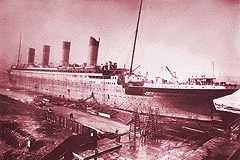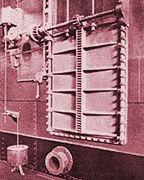 After
her launch, Titanic was towed to Harland and Wolff's fitting out
basin. At the time of launching, she was little more than a shell of
steel. She would eventually acquire her four trademark funnels (the fourth
of which was in fact cosmetic) and the appointments that would result in
her being labeled a "floating palace."
After
her launch, Titanic was towed to Harland and Wolff's fitting out
basin. At the time of launching, she was little more than a shell of
steel. She would eventually acquire her four trademark funnels (the fourth
of which was in fact cosmetic) and the appointments that would result in
her being labeled a "floating palace."Specifications for Titanic were almost identical to those of Olympic. However, while White Star and Harland and Wolff were learning about Olympic during her transatlantic service, they took advantage of their knowledge by improving upon the plans for Titanic. One late modification on Titanic was due to complaints by passengers of being splashed by bow spray while walking on the A deck promenade of Olympic. On Titanic this problem was resolved by enclosing the forward portion of the A deck with sliding windows. The inclusion of the Café Parisien, a restaurant with the character of a French sidewalk café, was another distinguishing addition that set Titanic apart.
 Titanic's
refinement and excellence could be found in all aspects of her
construction. Safety was of the utmost importance, reflected by her
double-bottomed hull and complex system of watertight compartments. With
the watertight doors closed, Titanic could remain afloat with any
two of her sixteen compartments flooded. Moreover, she could remain afloat
with any three of the first five compartments flooded, and even with the
first four full. Such features prompted the periodical The Shipbuilder
to deem Titanic "practically unsinkable."
Titanic's
refinement and excellence could be found in all aspects of her
construction. Safety was of the utmost importance, reflected by her
double-bottomed hull and complex system of watertight compartments. With
the watertight doors closed, Titanic could remain afloat with any
two of her sixteen compartments flooded. Moreover, she could remain afloat
with any three of the first five compartments flooded, and even with the
first four full. Such features prompted the periodical The Shipbuilder
to deem Titanic "practically unsinkable."Furnished with twenty lifeboats and capable Welin Quadrant davits, Titanic also exceeded the legally required number of lifeboats, despite the need for over three times this number to accommodate all of her passengers. Then there was the Marconi wireless, a somewhat new communication device for the time period. It was an important safety feature however, allowing operators to transmit distress calls in the event of an emergency. The Marconi radio aboard Titanic was the most powerful of any passenger vessel of the day.